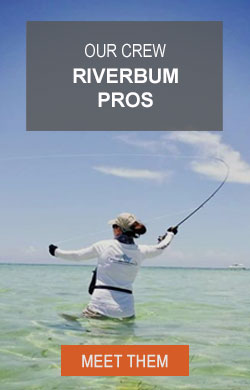How To Cast Big and Heavy Flies [3 Tips From A Professional Casting Instructor]
Have you ever switched out to a heavy streamer recommended at the shop and struggled to cast it?
How about just trying to get it out of the water and have it catapult back, narrowly missing (or not) you?
How about those floating stoneflies and hoppers?
The information here can be applied to casting big sinking flies and some big floating flies.
Think about a big dry fly, like a size 6 Stimulator or Chernobyl and some bass bugs, or heavy flies, like streamers that cast like a wet sock.
Casting these flies requires understanding and applying items described below.
Optimize rod weight, line, leader, and tippet.
A 6-wt. rod will handle those streamers much better than a 4 wt. and will also handle big bushy dry flies more easily.
If you use big flies frequently, especially streamers, consider a specialty fly line.
These lines are designed to cast heavily weighted flies. Leader configuration is important.
Bigger flies often can be fished with shorter leaders, and it is easier to cast them also.
Streamer leaders can often be as short as 6 ft., and some manufacturers are making 6 ft. leaders now. The skinniest part of the leader, or tippet section, is critical.
The “rule of three” states: tippet ‘X’ size = fly size/3. Therefore, a size 6 streamer would employ a 2X tippet, a size 4, 1X or 2X, and so on. Follow these guidelines and adjust your tippet accordingly.
You will have better control and leader turnover if the mass and flex of the tippet matches the fly size, and remember it is a guideline.
Do not be afraid to go up or down one “X” size or two. Trying to use thinner tippet and longer leaders with big or heavy flies (a size 6 hopper or size 6 Woolly Bugger with a 9 ft., 5X leader, for example) will cause struggles, tangles and cursing.
The way to avoid the scary catapult effect of a sunk fly coming out of the depths and breaking through the surface is to use a roll cast before picking up. The roll cast brings the sunk fly closer, or to the surface.
For some flies more than one roll cast may be needed.
When you see the fly flip over near the surface, immediately go into the pickup (back cast). This offers much better control and safety.
If your roll cast skills need help find someone, like a Certified Instructor, and learn how to improve it.
Opening the casting loop is helpful.
First, it helps keep the big, heavy fly away from the rod tip (and you)!
Nothing is worse than knowing you nicked the rod with those dumbbell eyes, or worse, broke it!
Second, the open loop loses energy faster because of more wind drag and the delivery or turnover is slower.
The mass of the heavy fly often helps with turnover, and less energy softens the “clunk” or tug that one feels as the line/leader straightens.
Feeling that tug may sound like a good thing for timing, but if the tug is so hard that it causes the line/leader to recoil and tangle, you are in trouble especially with double nymph and streamer rigs.
Another casting strategy is the oval or Belgian cast.
This cast comes back in a near horizontal plane and circles up immediately into an overhead cast without a back cast stop.
Everything stays under continuous tension, and lines under continuous tension cannot tangle.
Almost all my streamer fishing employs this cast. It works with nymph rigs, too.
Finally, consider force v. speed.
Intuitively, many anglers put on a heavy fly and move it faster—and struggle.
I know I did when I first started out.
It does take more force to get the heavy fly out of the water and going, but once it is moving, the extra speed is unnecessary.
The physics formula for momentum tells us this: mass x velocity. If we increase the mass (weight) of the line, leader, and fly by increasing the mass of the fly, we don’t need more velocity for the same momentum, or energy in the cast. Imagine swinging a rope in a big circle.
It takes a certain amount of force to move it at a certain speed.
Now imagine attaching a baseball to the end of the rope and swinging it around. It will take more force to get it going, but you will not have to move it faster to keep it going. In fact, one could probably move it slower than you did without the weight added.
Keep this in mind as you cast heavy flies and rigs.
Now, let’s take that lightweight but air-resistant bushy dry fly.
Imagine the same rope mentioned above but attach a beach ball. When swinging this around, one does need more speed to overcome some air resistance, but not so much as to create excessive resistance.
This one is tricky, because if we move it faster, the resistance quadruples for every doubling of speed.
Casting a tight (4 ft. or less) loop with a straight top leg and using the appropriate leader and tippet are the answers. There may need to be some increase in line speed, but not as much as one might think.
The same is true for a large dry fly with a sinking dropper—a very popular way to fish.
Bottom Line
Make sure you have the correct length leader and tippet size for the fly, consider specialized streamer lines if you fish these often, open the casting loop a bit for bigger--and especially heavier--flies and rigs, learn the roll cast and Belgian or oval cast, and resist the temptation to speed up the stroke excessively with heavier flies and lines.
Happy Fishing!!

![How To Cast Big and Heavy Flies [3 Tips From A Professional Casting Instructor] How To Cast Big and Heavy Flies [3 Tips From A Professional Casting Instructor]](https://cdn11.bigcommerce.com/s-5020eou/images/stencil/190x250/uploaded_images/casting-big-flies.jpg?t=1696978507)





